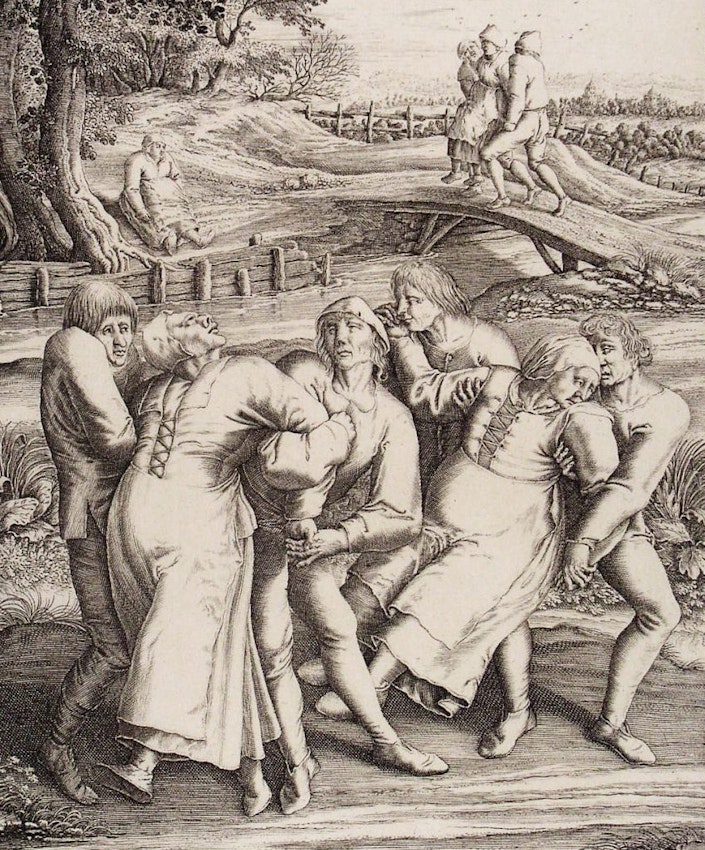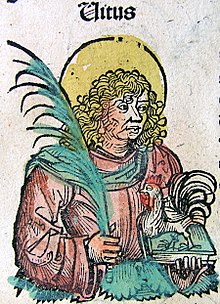One summer day in July of 1518, a young woman in the French town of Strasbourg walked out into the street and began to dance. Despite the sweltering heat and lack of any accompanying music, the woman danced, and she didn’t stop. Soon, a few more people joined her, then a few more…

After a week, the dancers still showed no signs of slowing down, and their numbers kept growing. They kept dancing day and night, and they rarely stopped for food or drink. Somewhat alarmed, the city councilors turned to local doctors to see if there was an explanation for the feverish dancers overtaking their streets. And what, you may ask, was their groundbreaking medical revelation: hot blood. The medieval doctors believed that all of the twisting, twirling, and shaking was a way for people to cool down their overheating blood. Seriously. I don’t know about you, but moments like this make me very grateful for modern medicine.
So, in order to accommodate the dancing peasants, the city constructed a stage and even brought in musicians. However, as the days rolled by, the dancing fever began to take its toll. Dancers began to collapse from exhaustion, and some reportedly even died from the exertion of constant dancing. At its peak, it was reported that as many as 400 people were involved in the mass dancing craze, and, according to a writer living close to the city, up to 15 people a day were dying (although this source was never corroborated). Finally, after 3 months of dance mania, the city banned dancing, and the afflicted peasants were put in the hospital or shuttled to a mountaintop shrine to pray for absolution.
As crazy as it may sound, the ‘Dancing Plague of 1518’ is a well documented 16th century event. In the modern era, scientists and historians have attempted to explain this bizarre phenomenon in a few different ways. One theory is that the bread eaten by the peasants was infected with ergot fungi. These fungi produce a chemical named ergotamine which is structurally similar to LSD, thus causing a massive drug trip among the town. This fungi was also implicated in other historical anomalies including the Salem witch trials. However, some scientists argue that this is an unlikely explanation.

The leading theory is that the dancing fever was an event of mass hysteria or mass psychogenic illness (MPI). MPIs are characterized by large numbers of people exhibiting the same bizarre behavior which seemingly spreads in an epidemic pattern. These events are usually associated with stressful environmental conditions. At the time, Strasbourg was suffering from widespread food shortages, new disease outbreaks, religious conflicts, and other stressors which undoubtedly took a toll on the peasantry. Additionally, historian John Waller has pointed to St Vitus, a catholic saint who Europeans believed had the power to curse people with a dancing plague, as another factor in the dancing epidemic. The townsfolk may have experienced mass hysteria from the stress of their environment which manifested in a belief that they were being cursed to dance.
Fortunately for us, Penn State’s annual dancing maraTHON has yet to cause anyone to die from exhaustion. However, if you see someone silently dancing alone in the street, maybe don’t join in.


I love the idea with this website, very entertaining and honestly funny. I’ve never heard of this before and now I’m so glad I have. I like how you provided the background and then explained why it may have occurred. After this post I’m going to keep checking in on your website just to hear more things like this.
I remember hearing about his somewhere, but I definitely hadn’t heard the part about St. Vitus. This is a super interesting blog topic to me because I love hearing random facts, even if they have no effect on my life whatsoever. Overall, I really enjoyed your post!
I really like this post and enjoy reading it because I learned something interesting from this! I actually never heard of people dying from constant dying. It’s intriguing to see different explanations of this phenomenon, and your post is very organized for me to follow and understand. Great job, I can’t wait for the next post!
I have definitely never heard of it, and didn’t entirely believe the blog post as I read it. I thought maybe the blog was going to be an experiment like “how much are people willing to believe?” But, I suppose this is a true event and sounds well documented. I am just as confused as the doctors, but great work!
This is really interesting and well-explained, I love the blend of biology and history! I’d never heard of MPIs before, and I wonder how many other crazy events in history can potentially be explained by this. I also really like that the city just went along with the peasants’ random dancing and brought music as well.